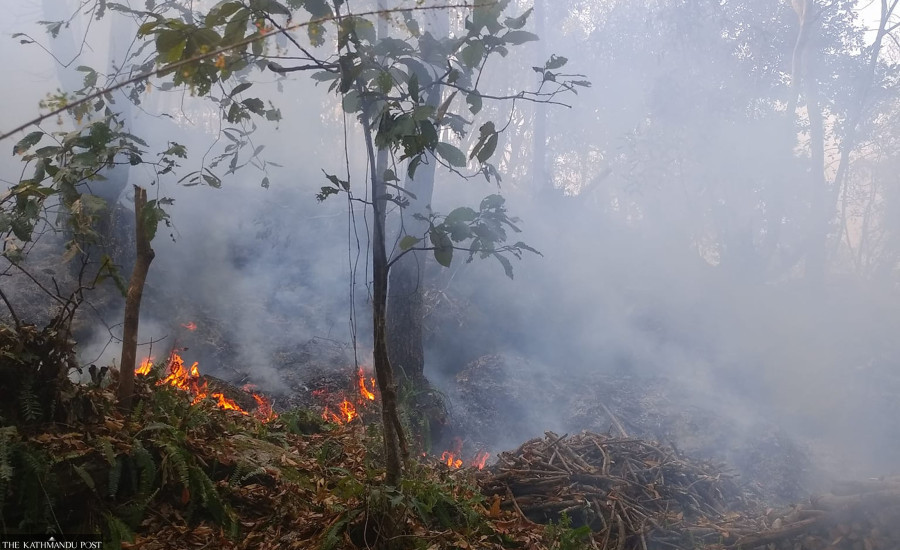National
Elderly people increasingly falling victim to forest fire incidents
Growing outmigration has left villages devoid of youth, forcing the elderly and children to take on the role of first responders to forest blazes.
Arjun Poudel
Last month, a 49-year-old woman from ward 8 of Kharpunath Rural Municipality in Humla district sustained serious burn injuries while trying to contain a massive forest fire near her home. The fire had caught her clothes, when the woman had tried to beat back the raging inferno with green twigs and dirt.
The fire was accidentally started by children, who were playing near her home. “There were no male members in my family or in neighbouring households or even health workers to attend to me,” the victim said.
“This is a problem of every village,” said Dilli Giri, secretary of the Federation of Community Forest Users Nepal. “As most villages are becoming devoid of young males due to migration, there are only women, elderly people and children left behind. When a fire breaks out in the nearby jungle, they are the ones who have to act as first responders.”
Wildfires are common in Nepal during the dry season.They may occur naturally or through human activities and errors, but hotter and drier conditions make them fierce and uncontrollable.
Human actions—discarding cigarette butts without stubbing them out, burning dry vegetation to clear farmlands, and deliberate burning by grazers and poachers—are considered the main reasons for forest fires.
Experts warn that incidents of forest fire are likely to increase this year due to the prolonged drought and accumulation of biomass in the wild for a long time to provide ample fuel. And what concerns them is the lack of youth in the villages, leaving the elderly and children more vulnerable to injury and death from forest fires.
“Most victims, who had either died or gotten injured in forest fire-related incidents in the past several years, were elderly people and women,” said Giri. “People residing in the villages are ill-equipped and untrained to deal with forest fires. Women and elderly people cannot even escape the fire due to the nature of their clothing, and age.”
Last year, four villagers from ward 2 of Bhumikasthan Rural Municipality of Arghakhanchi district, died while trying to put out a forest fire in a community forest using green twigs and dirt. The deceased were men aged 72, 55, 52 and 36.
Another man of 70 from Ramechhap also succumbed to burn injuries, which he sustained while trying to beat back forest fire.
In 2021, a 65-year-old man from Doti district had also died, while trying to douse a forest fire.
“Elderly people and children cannot figure out the risk, and it is impossible to beat back the raging inferno with green twigs and dirt,” said Anil Pokhrel, executive chief of the National Disaster Risk Reduction and Management Authority. “Growing migration of youths from the country has become another challenge in controlling wildfire and preserving forests.”
In 2023, 1.7 million people left the country, including students and 700,000 migrant workers.
In Nepal, the forest fire season starts in March and peaks in April and May.
The forest fire season has just started and the country has already recorded over 200 incidents, according to officials at the authority.
The number of fire incidents is expected to rise in the coming days throughout the country, as the mercury is rising with only a small chance of precipitation in the next few days.
Nepal’s valuable forests, which took more than six decades to restore, face a worsening wildfire reality with scarce resources and nearly zero strategies to prevent or fight it. The country has increased forest coverage by 45 percent from around 41 percent in 2019. However, growing incidents of forest fires threaten progress, according to experts.
“Along with launching an awareness drive about the risk of forest fire, we should also ask people not to go to forests if there is out-of-control fire and wind is blowing from all directions,” said Pokhrel. “We have lost several security personnel to wildfires in the past. Ill-equipped women and elderly people should stay away from big fires.”
In 2009, 49 people, including 13 Nepal Army personnel, died in Ramechhap district while fighting a wildfire.
Experts say wildfires have not only threatened years of progress made by the country, but also risked lives and livelihoods, ecology, and the environment.
“Strengthening local governments, imparting training to locals, providing them with necessary kits to deal with possible fire incidents, and building artificial ponds, are among the ways to deal with fire incidents,” said Sundar Sharma, an under-secretary at the National Disaster Risk Reduction and Management Authority.
“Raising awareness about the consequences of deliberately causing forest fires, and penalising those responsible, could significantly reduce such incidents. We should also make people aware of the dangers of putting out fires.”
Humans are responsible for almost all incidents of forest fire in our country and over 60 percent of fire incidents are intentional, according to studies.




 11.12°C Kathmandu
11.12°C Kathmandu













%20(1).jpg&w=300&height=200)

